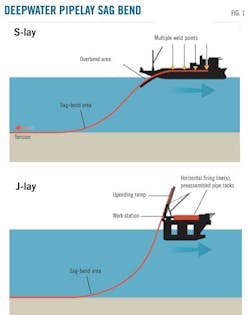Research nears deepwater intercontinental gas pipeline
Richard Freeman
Tata Steel
Corby, UK
Research into the collapse and buckling of deepsea pipelines and the UOE method of line pipe production are moving the industry closer to being able to build and operate intercontinental natural gas lines.
Currently, intercontinental transport of natural gas typically occurs via LNG tanker, not pipeline. The movement of natural gas by ship, however, requires a variety of steps—liquefaction, loading, transit, regasification—not required of pipeline transit. A proposed pipeline linking India to the Middle East across the Arabian Sea, for example, would eliminate the need for these steps while at the same time satisfying some of India's growing appetite for natural gas.
Current alternative onshore pipelines, originating in either Turkmenistan or Iran, would transit either or both Afghanistan and Pakistan en route to India, with attendant political and security concerns. A subsea intercontinental pipeline, however, would present many technical challenges.
Deepwater pipelines
As subsea pipelines are taken to greater depths (generally down to 1,000 m), external pressure may eventually become great enough to buckle and collapse the pipe. The pipe is particularly vulnerable during installation when the pipeline has no balancing internal pressure and the bending during lay (Fig. 1) further stresses its axial fibers.
Despite the apparent simplicity of this failure case, pipe collapse is a complex phenomenon involving plastic and elastic instability. The exact pressure at which the pipe fails is a function of the material properties of the steel, the geometry of the pipe, and its overall surface topography. Local variations in strength and shape lead to an inherent unpredictability of the exact pressure that would lead to catastrophic failure, adding further uncertainty and complication.
Engineers can use theoretical principles to estimate collapse pressure within a specific pipeline and much work has been done to evaluate these principles through full-scale testing. Exploration, however, now demands pipeline performance at such depths and with pipe of such large diameters (an inherent weakness against hydrostatic pressure) that current, conservative expressions and testing regimens form potential barriers to advancement of pipeline technology.
An offshore pipeline bringing natural gas into India from the Middle East would need to have sufficient diameter (26-28 in. OD) to transport gas economically. The pipe's route, however, would reach water depths of nearly 3,500 m (Fig. 2), requiring WT of more than 40 mm for those diameters.
This WT-OD combination is at the edge of current economical pipe-forming capabilities and would require construction of a specialized fleet of new lay vessels. Any WT reduction would yield significant material, installation, and logistic cost savings when considered along the total 1,100-km route.
Reducing WT by 2.5 mm, for example, would yield savings in material alone of about $80-100 million. A WT reduction could also be the difference between lay-barge capability and not being able to lay the pipe at all.
Displaying 1/4 Page1, 2, 3, 4Next>
View Article as Single page


